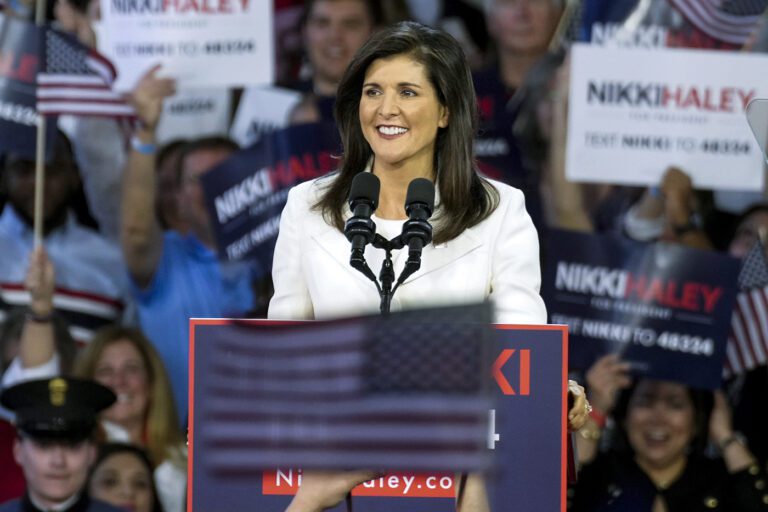Nikki Haley, former ambassador to the United Nations under President Donald Trump and governor of South Carolina, recently announced is running against President Donald Trump in 2024. She is the first, but certainly not the lastto challenge Trump for the Republican nomination.
When it comes to Haley, the first Indian-American woman to serve in a presidential cabinet, “there's not much of a book” on her campaign, she says Meg Heckman, assistant professor of journalism at Northeastern University. But there is precedent for how women are treated by the public and the media when they run for high office––and you don't have to look far to find it.
On Thursday, during CNN This Morning, Don Lemon said: “Nikki Haley is not in her prime” in reference to Haley's comments about requiring mandatory mental capacity tests for politicians over 75. Lemon received immediate pushback from his female co-anchors, who pressed him to clarify his comments (Lemon simply replied, “Don't shoot the messenger”). He later apologized for his comments, but the tone and implications behind his words are not new when it comes to the media's coverage of women candidates.
“That's been true since Victoria Woodhull was the first woman to run for president in the late 1800s,” Heckman says. “She was vilified, marginalized, condemned. There was Thomas Nast's infamous political cartoon that marked it Mrs. Satan.”
According research Heckman and her colleagues conducted gendered news coverage of Vice President Kamala Harris, those biases have not gone away. Despite political and cultural changes in the US since Woodhull's campaign, female candidates are still less covered than their male counterparts. And when they do get coverage, it has, historically, tended to “belittle them, denigrate them, focus more on their personal lives than their political position,” Heckman says. It can affect political aspirations of women and harm the way voters generally perceive women politicians.
“The biggest [challenge] it's this disconnect between how we've been socialized to think about what a leader should look like and how female candidates present themselves,” Heckman says. “In our society, we've been conditioned from childhood in many different ways and many different spaces that leaders are powerful white men.”
Politics is a game of vision. During an election campaign, a candidate's clothes, hair, inflections and body become fair game for political journalists to analyze. But Heckman says you don't have to look too far back in history to see how different that journalistic lens looks when it comes to female candidates.
“In many cases it's a lose-lose situation because if a woman comes across as too masculine, she's criticized in a way that Hillary Clinton was,” Hackman says. “She was made fun of for her pants. She was made fun of for her hair. She was made fun of for her voice, her height, her body type. On the other hand, if you present yourself as more feminine, you're treated like Sarah Palin was in 2008. Governor Palin was sexualized and objectified.”
Go back further and there it is By Elizabeth Dole 2000 Republican nomination bid. Or Geraldine Ferraro, the 1984 Democratic nominee for vice president, whom a Denver Post columnist wrote Woodrow Page he would be the first vice president to be able to enter a wet t-shirt contest. And women of color running for office face additional challenges which may result reinforcing harmful stereotypes.
It's yet to be seen how this will affect Haley's campaign, but Heckman notes that there are differences in how female politicians are positioned across the political spectrum. Haley kicked off her campaign by saying, in a not-so-subtle reference to Trump, “You should know this about me, I don't put up with bullies. And when you kick back, it hurts them more if you're wearing heels.”
Heckman says candidates perform their femaleness differently depending on where they fall on the political spectrum, with an overwhelming focus on white women.
“You frame conservative womanhood as 'I believe in traditional gender roles and I support the patriarchy in many different ways and I leverage white womanhood to keep other marginalized groups in check,'” says Hackman. “Then the more liberal femininity plays a little more clearly feminist, perhaps speaking a little more explicitly about issues around gender, privilege and power.”
As a woman of color in the Republican party who is the daughter of Indian immigrants, Haley also will likely face what Heckman says is a general sense of novelty in the media when it comes to women and women of color. Labeling a candidate as “the first woman” or “the first woman of color” may seem like an acknowledgment of a milestone, but it often comes at the cost of focusing on a candidate's policies, Heckman says.
If, in 2024, Haley is alone on the debate stage surrounded by a crowd of Republican men, it's likely that very little will change. But as the number of women running for office and serving in government increasesHeckman hopes some of these narratives will fall by the wayside.
“The more women run and the more women from different backgrounds run, the weaker the innovation trope becomes,” says Heckman. “When I think about the moment we're in in US politics, it feels really critical. The question will be, will women candidates be open to adopting policies that embrace gender equality in society?'
Cody Mello-Klein is a reporter for Northeastern Global News. Email him at c.mello-klein@northeastern.edu. Follow him on Twitter @Proelectioneer.



